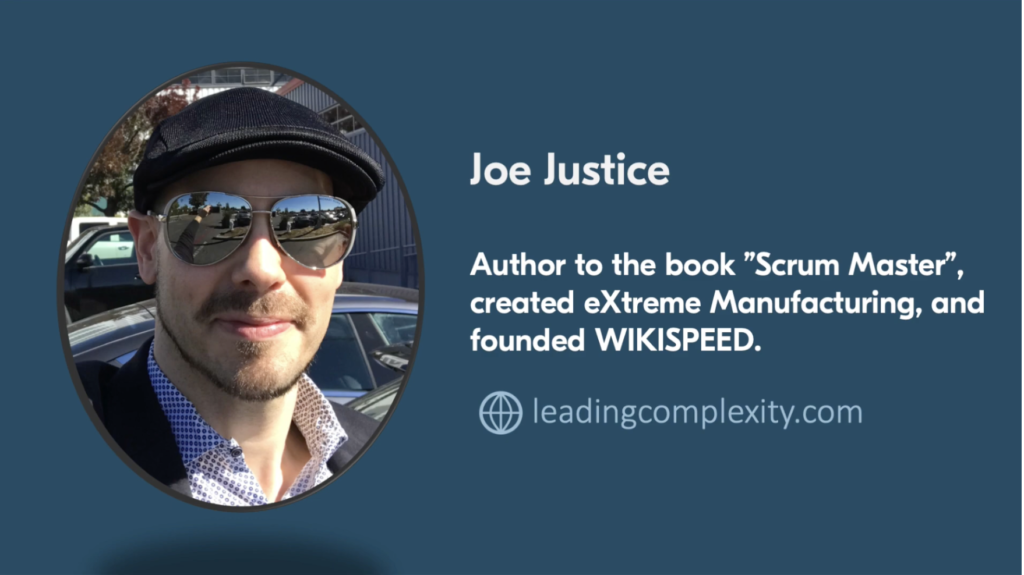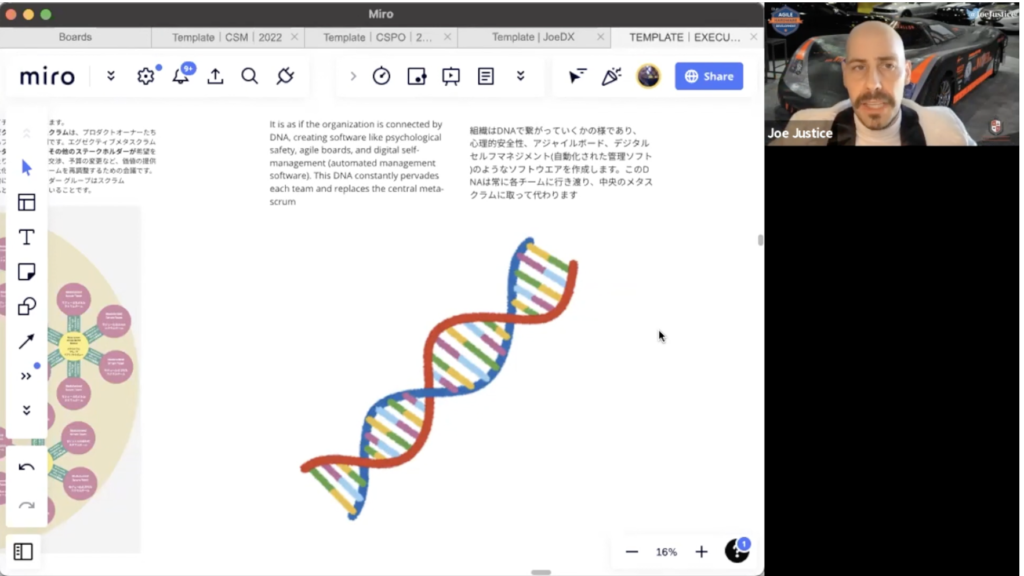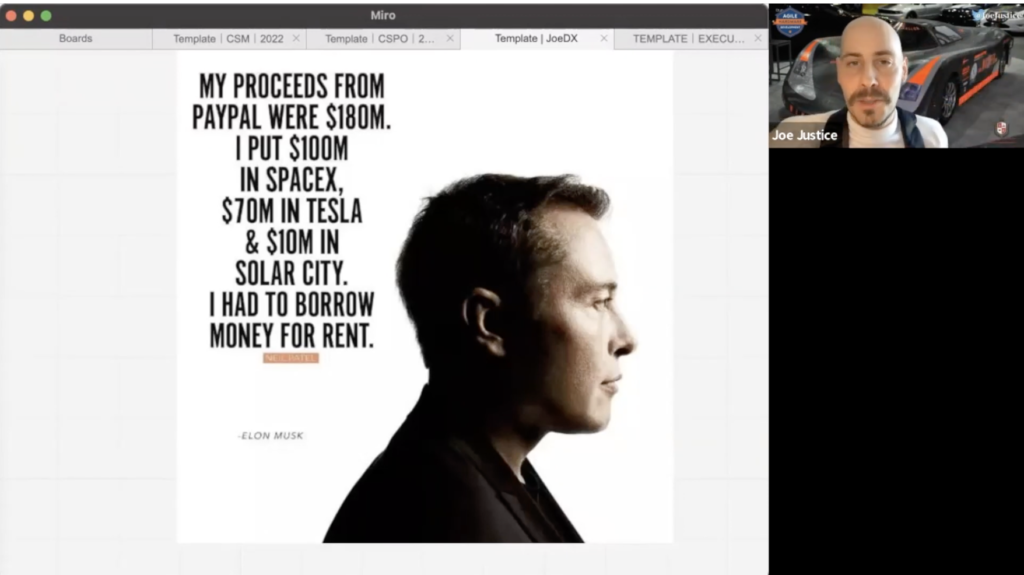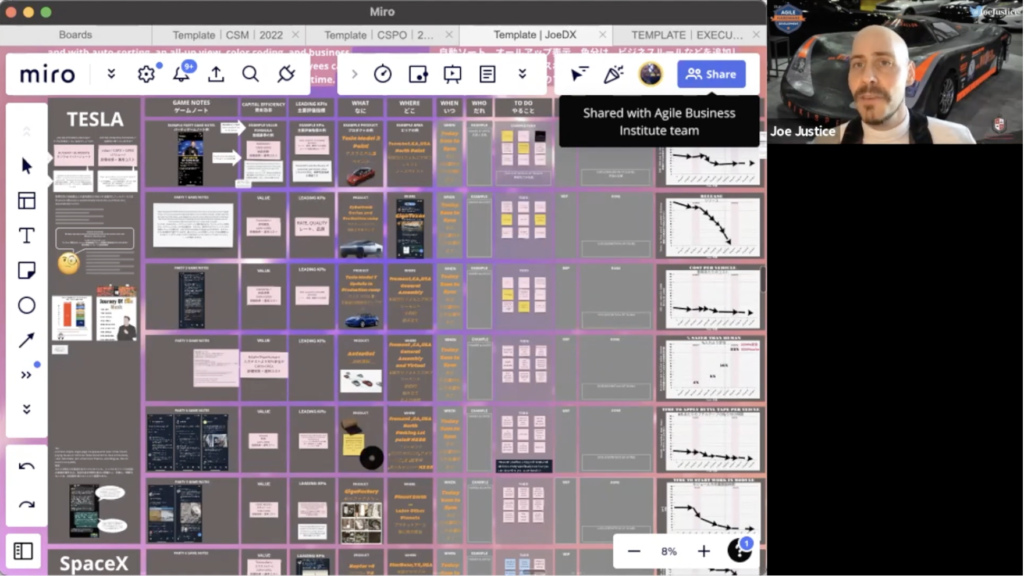Tesla. We’ve all heard of this innovative brand changing the automotive industry in the last decade. But how can one run a company that’s at the forefront of technological progress?
To help us understand this and more, we asked Joe Justice to be part of the Leading Complexity program.
In short, this is what he had to say.

Agile DNA: A Flat Leadership Structure

Joe starts the discussion by describing how the Musk organizations work. And even though some of these companies actually build rockets, the approach is no rocket science. It’s all about developing a concept that prioritizes speed and innovation enabled by a flat structure in each company.
Moving on, Joe argues that this type of framework leads to increased collaboration, ownership, and meaning. He describes this strategy as an Agile DNA.
“Teams truly do self-organize, and the reason I think they’re able to do that is because of Agile DNA.”
Joe Justice
Simply put, Tesla is not depending on managers but relies on highly motivated and skilled teams. Therefore, at the end of the day, everyone is equal. And thanks to such a flat structure, employees can take on multiple roles and responsibilities. Basically, each day, people working at Tesla, Elon Musk included, gather and work together in different groups known as “mobs.” As a result, it increases output and offers a greater sense of collective meaning.
Everyone is a Worker
As the keynote continues, Joe mentions several times that Elon Musk actually does what he preaches.
“Everyone eats the same food, uses the same restrooms, etc. There shouldn’t be this workers vs. management two-class system. Everyone is a worker.”
Elon Musk
In other words, Joe emphasizes that a leader has to serve their people and not the other way around. This principle is fundamental to Tesla’s unique approach to leadership. Because at Tesla, engineers are trusted to tackle complex problems and find solutions. And no one doubts their decisions.
Thus, it is safe to say that Elon Musk’s leadership approach is non-traditional. Tesla operates in a completely different way from most businesses.

So what happens is that managers rotate multiple times per day and have higher accountability. Yet, this doesn’t come with higher payments or authority. Everyone at the company earns basically the same salary, regardless of their position or role.As a matter of fact, manager training is accessible to anyone. To make things even easier, most approvals are automated by AI. Thus, “leaders” are contributors. They work in the same environment as the rest of the team, all contributing to the company’s mission.
Unusual Onboarding and Work Culture
But how do Tesla employees become so involved in the whole culture? To draw a picture of how this happens, Joe describes the onboarding process.
“You need to find how you can support the company mission and do it immediately.”
Joe Justice
Tesla has a unique approach that sets it apart from traditional companies. It’s a 4-hour onboarding process that is rigorous and challenging. Yes, it is designed to be intense. But it is also designed to help employees quickly understand the company’s mission and values.
And an unconventional leadership structure is not the only interesting part of how Tesla is run. Besides leadership, Tesla also has an unconventional approach to work hours and perks. Employees have to work 3 * 12-hour shifts per week. And each day, they are expected to come in and immediately support the company’s mission. No questions asked. Furthermore, annual reviews and promotions do not exist.
But people working at Tesla are trusted completely. This includes everything from simple work decisions to how they spend the company’s money. And that creates a deep form of bonding. One that makes people feel they belong. A bonding that makes them want to get involved in every possible way. And that includes preaching the company culture, buying its merchandise, and working extra hours.
Agile Hardware, Cross-Functionality, First Delivery: The Tesla Philosophy
So, in conclusion, it is safe to say that Tesla is governed by an unconventional approach to leadership and manufacturing context.

You can watch the full video to learn more and discover Joe’s 12-step plan to having an agile approach in a hardware manufacturing process. A plan that includes a factory culture open to new designs, digital self-management, modular hardware design, and more.
But the big secret behind how Musk companies function is straightforward. The key aspect is in the way they see leadership, which is a way that emphasizes cross-functionality.
“Elon Musk is famous for a very deep level of understanding on a very wide-ranging set of issues.”
Joe Justice
By placing all employees on the same level, the company is able to streamline its operations and achieve its goals more efficiently and effectively. In addition, by giving employees absolute freedom with finances, it enables everyone to choose the right tools for the job. Combining these aspects, the company innovates at a rapid pace, building a strong company culture and receiving astonishing results.
But should you copy the Tesla approach?
Even Joe laughs and says that organizations not owned by Elon Musk simply can’t apply his approach by the letter.
Thus, just as Henrik Kniberg said in his Leading Complexity talk, the key when adopting a leadership model is to adapt it to match each organization’s own needs and circumstances. Because that is the only way leaders can handle complexity and lead accordingly.
Do you want to learn more about Tesla’s Agile DNA? Attend one of Joe’s upcoming training sessions at Crisp.



